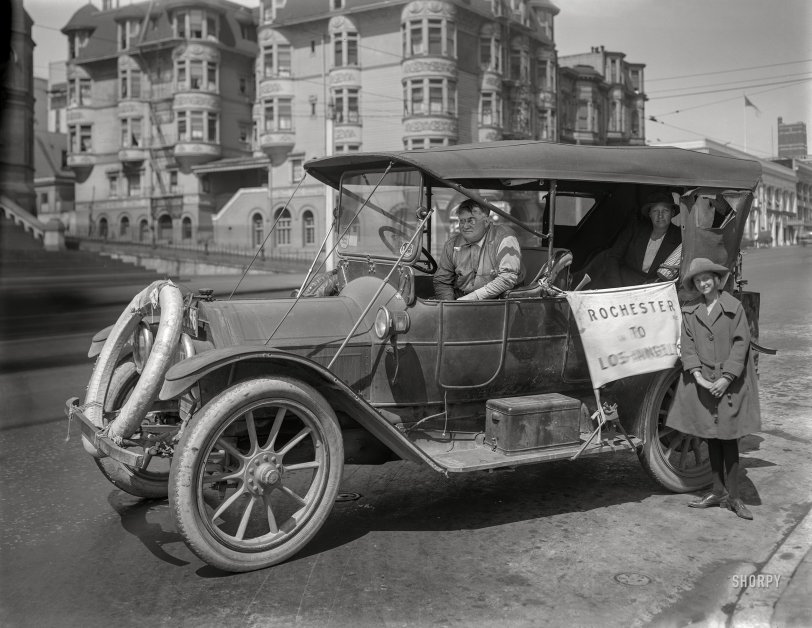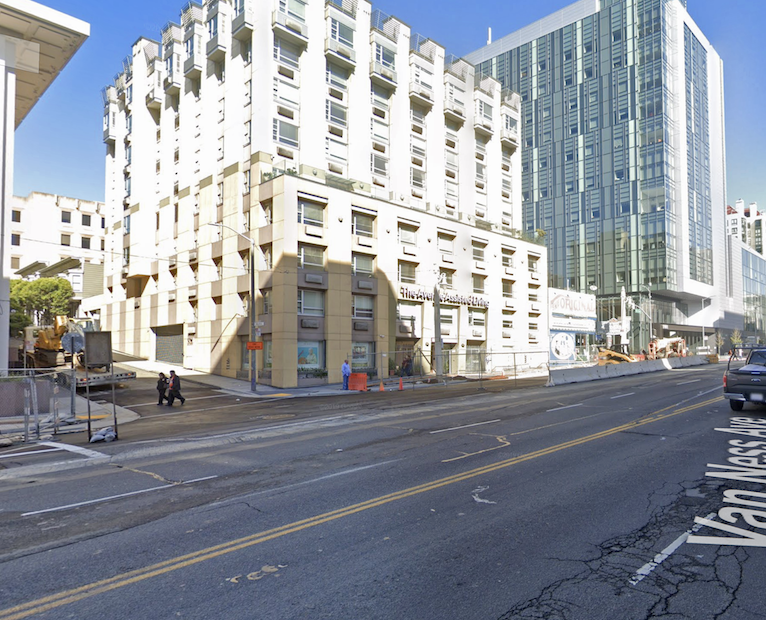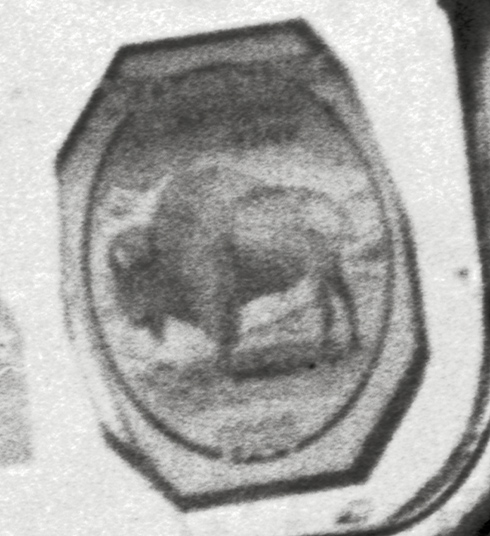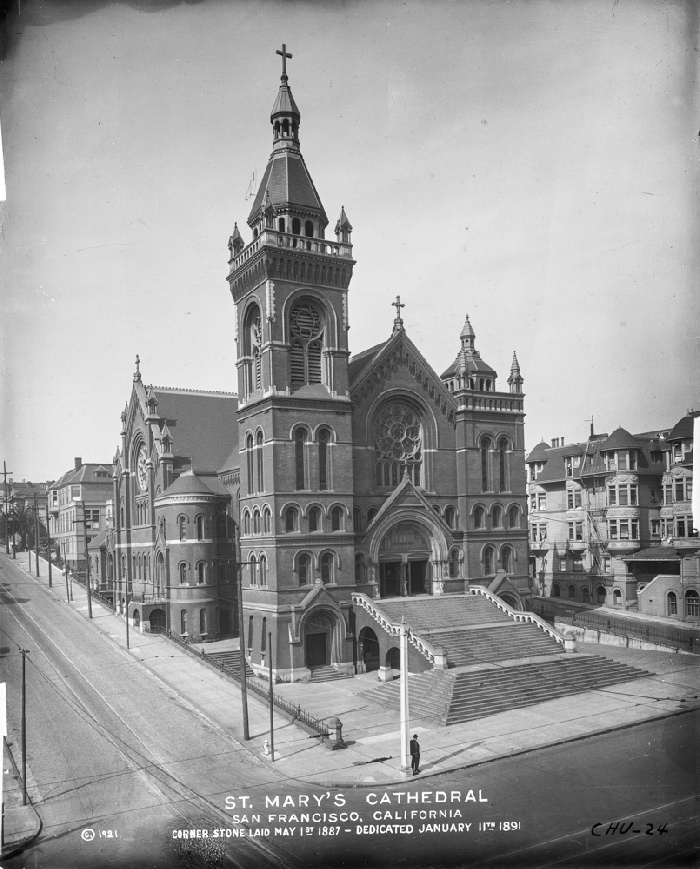


Framed or unframed, desk size to sofa size, printed by us in Arizona and Alabama since 2007. Explore now.
Shorpy is funded by you. Patreon contributors get an ad-free experience.
Learn more.

- Details, Details
- What's that building to the left of the tower?
- Coal Barges
- Bromo-Seltzer
- Inner harbor
- The Basin
- What a headache!
- Giant stepladder?
- Baldwin 62303
- Baldwin VO-1000
- Cold
- No expense spared
- Tough Guys
- Lost in Toyland
- And without gloves
- If I were a blindfolded time traveler
- Smoke Consumer Also Cooks
- Oh that stove!
- Possibly still there?
- What?!?
- $100 Reward
- Freeze Frame
- Texas Flyer wanted
- Just a Year Too Soon
- WWII -- Replacing men with women at the railroad crossing.
- Yes, Icing
- You kids drive me nuts!
- NOT An Easy Job
- I wonder
- Just add window boxes
Print Emporium
Rochester to L.A.: 1921

The place: Van Ness Avenue in San Francisco, with St. Mary's Cathedral at far left. The year: 1921. The subject: Three Easterners who've motored west in a battered Cadillac touring car. 6½ x 8½ inch glass negative, originally from the Wyland Stanley collection. View full size.
52 years later
My family made almost the same journey, moving from Ann Arbor to LA, in April of 1973.
We also took the long route through Texas to visit relatives. We had an Oldsmobile Cutlass of indeterminate age ( indeterminate because I was too young to know it ). My father went before us to start his new job. I can't remember how long it took. More than a week but less than 2? With a 6 and 2 year old in tow, I don't think Mom could drive for long stretches. I remember looking for motels that had SWIMMING POOLS. Very important to us snow birds.
In this digital age, the idea of just hoping to find a motel with vacancy seems hopelessly quaint. (Is that what those "No Vacancy" signs are for??)
I see a blowout in their future
The surface of that front driver's-side tire looks a bit sketchy. Good thing they have those spares.
[The closest side is the passenger side. - Dave]
Lucky to be alive and merely terminally dusty
The car is about a 1912 model so it wasn't new when they started out on their adventure. It was pre-battered from age and usage before they set out on the dirt roads of the day! The hood line into the cowl is the giveaway as to age. By 1914, Cadillac had faired in the hood line to cowl, instead of coming up abruptly to it. This one has an intermediate look with a bit of a rounded piece between the hood and cowl, although I cannot find its exact counterpart in a search. The top arrangement and windshield are also pre-war.
You kind of get the idea that this was a well-fed office gentleman, who lassoed his wife and daughter to come along for an adventure trip without having a clue what he was getting into. His rope knotting/lashing skills are, shall we say, basic. Cadillacs rarely had a trunk in those days; it was an optional extra, so the square attachment at the back, if they had any sense, was an auxiliary fuel tank. Gas stations out in the sticks were about non-existent and most of their trip was in the sticks. You can read stories of drivers running out of gas and telegraphing for more from a train-halt hamlet - it would then come by train freight to the stranded motorist.
People drove local due to the paucity of roads for fast travel to other places. Train was king for medium and long distance. When you read about the wondrous Lincoln Highway, you'd think things were finished by 1928, but that was when they really got serious about building it after years of glorious proclamations and not much action except here and there.
Considering its age and recent history, I think the car is in great shape. A bent-up piece of trim by the front running board and the torn rear top at the (non-existent) C-pillar are the only damage visible in this very hi-res image. It just needs a darn good wash, then wax and lube. You wonder if they sold it in California and hopped on a train for a nice comfy trip back to Rochester. By the look on Mom's face, I'd say that's exactly what they did.
Did they get lost?
It's not exactly the most direct route to L.A. to go via San Francisco. I suspect that they decided to do that to avoid traveling through the desert southwest. If they did this in summer that was probably a good idea.
[Or maybe they already got to L.A. - Dave]
Van Ness Ave has changed, oh wow
Sad to report that nothing remains of this view. The former site of St. Mary's Cathedral is now a TV station; an assisted living facility occupies the corner where the marvelously bay-windowed apartment house was located; and a towering Sutter Health medical facility has risen in the distance.

They Visited Yellowstone
The octagonal decal on the left side of the windshield is an admission sticker from Yellowstone National Park depicting a bison. Decals for the National Parks were given out with payment of admission. Apparently some windshields got so cluttered that the practice was eventually abandoned. For more info: http://npshistory.com/newsletters/courier/arrowhead/v8n2.pdf
I'm sure that the parks could raise some needed funding if they offered them again.
[Also seen here. - Dave]

RE: Headlight much?
OK but what's that spare tire-shaped thing obscuring the headlights?
[It's a third spare. Which is where it is because the spare holder on the side of the car is full. - Dave]
A different view
Here are the same two buildings seen in a view looking southeast to go with the Shorpy view to the northeast:
http://opensfhistory.org/search/index.php?q=St.+Mary%27s+Cathedral&_ds=1...
St. Mary's burned in 1962 and was replaced with a television studio.
My mother's family did this!
Seeing this picture reminds me of a story about my mother. Her family traveled by car west from Indiana to California when she was a child. This was a few years later than the picture above - probably in the mid 1920s.
Years later, when I was a teenager (late '60s) we took a trip to California with our travel trailer on the Interstate highways. My mother pointed out a small gravel/dirt road off to the side of the highway and remarked that ALL the roads they traveled on were like that!
How long was the trip?
In 1919, it took a young Army officer by the name of Eisenhower, leading a convoy of Army vehicles, 62 days to travel from the East to West coast.
Headlight much?
I guess they didn't do much driving at night. Or maybe there's a really good reason I can't come up with that kept them from strapping that spare onto the back.
[The spares are on the side. In back is the trunk. -Dave]
Good for them
That must have been a hell of an adventure in that car in 1921. And taken quite a while.
The driver as well
looks a bit "battered", but I suppose we all would be feeling it after close to 3,000 miles in that car on the roads of the day!

























On Shorpy:
Today’s Top 5